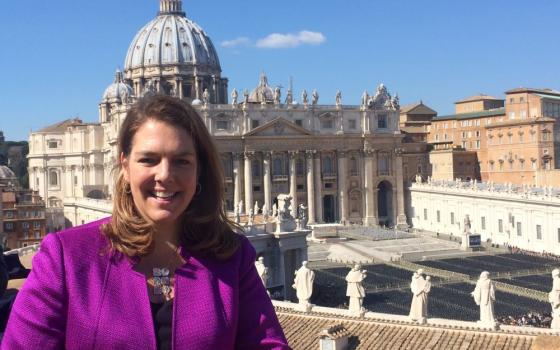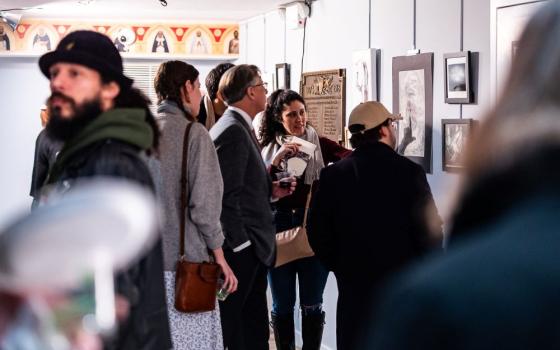[Editor's note: John Allen's column is being posted early this week, because his usual posting day, Friday, is Jan. 1, New Year's Day and the Feast of Mary, Mother of God.]
'Tis the season for end-of-decade countdowns, like “best baseball comebacks” and “worst fashion blunders.” In that spirit, this column is dedicated to the biggest Vatican stories of the first decade of the 21st century.
Usually these lists reflect somebody’s opinion, and they’re designed more to entertain than to edify. You rarely learn anything you didn’t already know, but the debates they trigger can be loads of fun, and I considered going that route. For example: “Biggest Vatican stories that never happened,” including the resignation of John Paul II or a sweeping reform of the Roman Curia under Benedict XVI. Another would be “most under-appreciated Vatican stories,” such as the fact that despite the church’s reputation for strict uniformity, we now have a de facto policy of liturgical pluralism within the Latin Rite (the extraordinary form for the Tridentine liturgy and new Anglican personal ordinariates, assuming they ever get off the ground.)
In the end, however, I decided to take a more empirical tack, seeking to identify what really were the decade’s biggest Vatican stories in the American media market. I did two month-by-month keyword searches under “Vatican” using Lexis-Nexis, the most comprehensive on-line media database, one for headlines in major American publications and the other for mentions in transcripts of national radio and TV broadcasts. Both searches began in January 2000 and ended in December 2009.
Of course, “most covered” and “most important” are hardly equivalent terms, but at least we can say with certainty which Vatican stories of the past decade generated the most buzz in the United States -- making them most likely to shape the perceptions of the average American about what the Vatican and the pope are up to.
At the big-picture level, the results should surprise no one. By a considerable margin, the three stories that topped the charts were:
- The sexual abuse crisis
- The death of John Paul II and the election of Benedict XVI
- The visit of Benedict XVI to Washington and New York in April 2008, the lone papal journey to the United States during the decade.
Of the three, the John Paul II/Benedict XVI story was easily the biggest. In an average month during the last decade, there were roughly 71 headlines about the Vatican in the United States, but in April 2005, that number soared to 573. In the broadcast arena, the spike was even greater. Considering coverage in January, February and March of 2005, when John Paul’s illness was the lead global story, the papal transition accounted for a staggering one-third of all mentions of the Vatican by national radio and TV outlets for the entire decade.
Other stories that produced significant up-ticks were:
- John Paul II’s March 2000 visit to the Holy Land.
- The 25th anniversary of John Paul’s election to the papacy in October 2003, coupled with speculation about the next pope.
- Pope Benedict XVI’s Sept. 12, 2006, lecture at Regensburg, which triggered a firestorm of protest across the Islamic world by appearing to link Muhammad with violence.
- Benedict’s June 2007 decision to authorize wider celebration of the old Latin Mass.
- Debates over the relationship between Catholicism and other religions (including a tough 2000 Vatican document titled Dominus Iesus and several investigations of theologians).
- The Vatican’s critical reaction to the U.S.-led war in Iraq in 2003.
- A 2005 Vatican ruling that homosexuals should not be admitted to seminaries, meaning that they should not become priests.
- Faith and politics, including the Vatican’s still-debated position on refusing communion to pro-choice Catholic politicians, and its openness to U.S. President Barack Obama.
- Catholic-Jewish relations, including stories that bookended the decade: The controversial beatification of Pope Pius IX in 2000, and movement towards sainthood for Pope Pius XII in 2009.
- Vatican reaction to two pop culture sensations: Dan Brown’s The Da Vinci Code and Mel Gibson’s “The Passion of the Christ.”
The two charts in this column illustrate the spikes in print or broadcast coverage, or both, associated with each of these storylines.


While little of this is especially shocking, there are at least three interesting lines of reflection suggested by the data.
1. The Difference between Print and Broadcast
The most obvious impression that literally leaps off the two charts is that while the death of John Paul II and the election of Benedict XVI were only relatively more covered in print, it was a landslide winner in broadcast. The papal transition accounted for around ten percent of print coverage of the Vatican during the decade (narrowly edging out the sexual abuse crisis), but a full one-third of broadcast interest.
In a sound-bite, the death of John Paul and election of Benedict XVI was by far the greatest TV phenomenon of the decade, but only a relatively more compelling print story.
Other differences also emerge. John Paul’s October 2003 anniversary (which included a consistory for new cardinals) was a big broadcast story, but didn’t make much of a dent in print, while the opposite was true for the theological controversies ignited by Dominus Iesus in 2000 -- it was a big deal in print, but didn’t generate as much heat in the TV world. The two Holy Land journeys of the decade, John Paul in March 2000 and Benedict XVI in May 2009, produced jumps in broadcast coverage big enough to show up on the charts, but less so in print. (That’s especially true of Benedict’s trip.)
The explanation seems reasonably obvious: Stories with a dramatic visual and audio component are more likely to be widely followed by broadcast media, whereas stories about policy or theological disputes are more at home in the print world. The Vatican has always been adept at stagecraft, which makes it a natural for TV.
Given that contrast, it might be an interesting exercise for a Catholic college to conduct a study of differences in perception of the Vatican and/or the pope among Americans who are mostly dependent upon TV for their news (presumably, a substantial majority) and those whose outlooks are more shaped by newspapers and journals. Though it’s no more than a working hypothesis, my hunch would be that people more attuned to broadcast media may have a slightly sunnier impression of where things stand.
2. Impressions of Media Bias
Among some Catholics, it’s an article of faith that the secular media in the United States is hostile to the Catholic church. During the past decade, that conviction was solidified by the sexual abuse crisis, and amplified by the way the media sometimes cast the church as a heavy in the culture wars over abortion and homosexuality.
Simply adding up the total number of references to the Vatican doesn’t distinguish between positive and negative coverage, but it’s worth noting that two of the three clear winners for biggest stories of the decade were, by common reckoning, good ones for the Vatican: the global outpouring of affection for John Paul II at the time of his death, and the visit of Benedict XVI to the United States. Polls taken shortly after that trip showed the new pope winning high marks for his candor on the sex abuse issue, including the first-ever papal session with victims, and for the image of basic kindness he managed to project.
CNN actually carried three papal events more or less bell-to-bell during Benedict’s American swing: a Mass at Nationals Stadium in Washington, D.C., a Mass at St. Patrick’s Cathedral in New York, and the concluding Mass at Yankees Stadium. That had to be a record for most Catholic liturgy ever broadcast on an American commercial network in a single week. (As CNN’s commentator during those events, I can add a touch of personal astonishment that there’s actually money to be made simply by knowing the parts of the Mass!)
To be sure, the sex abuse story was a cancer for the church, including the Vatican, which ran throughout the decade. Coverage in the decade pre-dated the American crisis, beginning with revelations in March 2001 (first reported in NCR) about the sexual abuse of nuns in Africa by priests, and a November 2001 apology by John Paul II to the church in Oceania for sexual abuse by priests and religious. There were plenty of other negative storylines too, including fallout from Benedict’s Regensburg lecture and his decision to lift the excommunication of the Holocaust-denying (or, at least, Holocaust-minimizing) Bishop Richard Williamson.
Nevertheless, looking back at patterns of coverage over the last ten years, it’s difficult to sustain an impression of systematic anti-Catholic or anti-papal bias. On the whole, the press in this country seemed to cover the good with the bad -- and, based purely on statistical counts, the good (from the Vatican’s point of view) often seemed to prevail.
3. The Two Popes
Comparing the two popes of the decade, John Paul II is conventionally seen as the more charismatic media figure, and that’s certainly reflected in TV and radio coverage. Setting aside April 2005, when the two popes overlapped, John Paul was mentioned on American TV and radio an average of 89 times a month during the first half of the decade, roughly a 25 percent better clip than Benedict’s average of 66 references a month.
In print, however, Benedict XVI actually comes out slightly ahead. During the 63 months that John Paul reigned during the decade, the Vatican garnered 71.3 headlines a month, while over Benedict’s 56 months the average was 71.9.
Those numbers seem to confirm a bit of conventional journalistic wisdom, which is that while John Paul II was the ideal pope for the TV age, the cerebral Benedict is often better suited to print. My friend and colleague Delia Gallagher was, I think, the first to say that Benedict XVI is a great pope for the Internet, because he’s meant to be read, and virtually every word he either speaks or publishes is now available in real time.
Here’s a final impression, which I can’t confirm statistically, but it reflects my experience: Much coverage of John Paul II during the first half of the decade was cast either in the past tense or the future, while Benedict’s is more firmly in the present.
That is to say, a dominant storyline regarding John Paul II from 2000 to 2005 was the health watch. (I used to grouse that I lived for the day when I would never again have to begin a TV bit with the phrase, “Well, I’m not a doctor, but …”) Much print and broadcast coverage was either retrospective, looking back at John Paul’s legacy, or trying to peek ahead at what (and, inevitably, who) might come next.
A much greater share of Benedict’s coverage has been rooted in the here-and-now. He’s been in office less than five years, so legacy pieces are premature, and there’s been no health scare to kick-start speculation about a successor. While he’s amassed a mixed record as a communicator, at least his major stories have been about substantive issues: the “clash of civilizations” between Islam and the West, his battle against a “dictatorship of relativism,” Christian-Jewish relations, faith and politics (including the relationship between the Vatican and the Obama administration), and so on.
In other words, we’re in that “sweet spot” within a papacy in which the focus is on ideas -- we’re beyond profiling the new guy or summing up his early moves, but not yet ready for obits and prognostications. Moreover, that sweet spot could last a while, since there’s little indication that Benedict XVI is on the brink of decline.
As I’m fond of saying, German machinery is built to last. The way Benedict XVI rebounded from that collision on Christmas Eve would seem to suggest he’s remarkably resilient for a guy of 82 … but, of course, I’m not a doctor.




